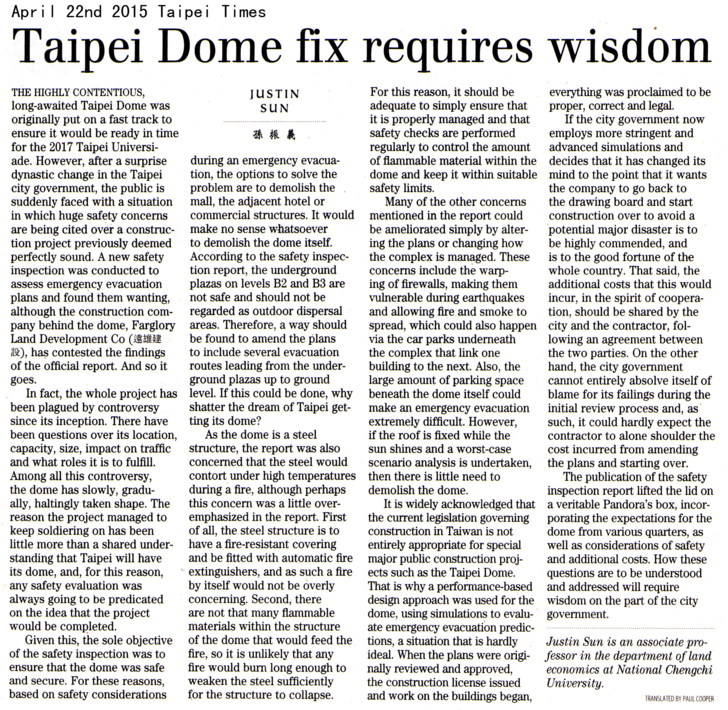

 字體:小 中 大
字體:小 中 大 |
|
|
|
| 2015/04/22 12:07:48瀏覽287|回應0|推薦0 | |
Taipei Dome fix requires wisdom (大巨蛋改善需要智慧)【Taipei Times 2015.04.22】 原始網址:http://www.taipeitimes.com/News/editorials/archives/2015/04/22/2003616486 此文是2015/4/17刊登於聯合報之「有蛋 應是大巨蛋安檢前提」翻譯 By Justin Sun 孫振義 The highly contentious, long-awaited Taipei Dome was originally put on a fast track to ensure it would be ready in time for the 2017 Taipei Universiade. However, after a surprise dynastic change in the Taipei city government, the public is suddenly faced with a situation in which huge safety concerns are being cited over a construction project previously deemed perfectly sound. A new safety inspection was conducted to assess emergency evacuation plans and found them wanting, although the construction company behind the dome, Farglory Land Development Co (遠雄建設), has contested the findings of the official report. And so it goes. In fact, the whole project has been plagued by controversy since its inception. There have been questions over its location, capacity, size, impact on traffic and what roles it is to fulfill. Among all this controversy, the dome has slowly, gradually, haltingly taken shape. The reason the project managed to keep soldiering on has been little more than a shared understanding that Taipei will have its dome, and, for this reason, any safety evaluation was always going to be predicated on the idea that the project would be completed. Given this, the sole objective of the safety inspection was to ensure that the dome was safe and secure. For these reasons, based on safety considerations during an emergency evacuation, the options to solve the problem are to demolish the mall, the adjacent hotel or commercial structures. It would make no sense whatsoever to demolish the dome itself. According to the safety inspection report, the underground plazas on levels B2 and B3 are not safe and should not be regarded as outdoor dispersal areas. Therefore, a way should be found to amend the plans to include several evacuation routes leading from the underground plazas up to ground level. If this could be done, why shatter the dream of Taipei getting its dome? As the dome is a steel structure, the report was also concerned that the steel would contort under high temperatures during a fire, although perhaps this concern was a little over-emphasized in the report. First of all, the steel structure is to have a fire-resistant covering and be fitted with automatic fire extinguishers, and as such a fire by itself would not be overly concerning. Second, there are not that many flammable materials within the structure of the dome that would feed the fire, so it is unlikely that any fire would burn long enough to weaken the steel sufficiently for the structure to collapse. For this reason, it should be adequate to simply ensure that it is properly managed and that safety checks are performed regularly to control the amount of flammable material within the dome and keep it within suitable safety limits. Many of the other concerns mentioned in the report could be ameliorated simply by altering the plans or changing how the complex is managed. These concerns include the warping of firewalls, making them vulnerable during earthquakes and allowing fire and smoke to spread, which could also happen via the car parks underneath the complex that link one building to the next. Also, the large amount of parking space beneath the dome itself could make an emergency evacuation extremely difficult. However, if the roof is fixed while the sun shines and a worst-case scenario analysis is undertaken, then there is little need to demolish the dome. It is widely acknowledged that the current legislation governing construction in Taiwan is not entirely appropriate for special major public construction projects such as the Taipei Dome. That is why a performance-based design approach was used for the dome, using simulations to evaluate emergency evacuation predictions, a situation that is hardly ideal. When the plans were originally reviewed and approved, the construction license issued and work on the buildings began, everything was proclaimed to be proper, correct and legal. If the city government now employs more stringent and advanced simulations and decides that it has changed its mind to the point that it wants the company to go back to the drawing board and start construction over to avoid a potential major disaster is to be highly commended, and is to the good fortune of the whole country. That said, the additional costs that this would incur, in the spirit of cooperation, should be shared by the city and the contractor, following an agreement between the two parties. On the other hand, the city government cannot entirely absolve itself of blame for its failings during the initial review process and, as such, it could hardly expect the contractor to alone shoulder the cost incurred from amending the plans and starting over. The publication of the safety inspection report lifted the lid on a veritable Pandora’s box, incorporating the expectations for the dome from various quarters, as well as considerations of safety and additional costs. How these questions are to be understood and addressed will require wisdom on the part of the city government. Justin Sun is an associate professor in the department of land economics at National Chengchi University.
Translated by Paul Cooper |
|
| ( 時事評論|政治 ) |










